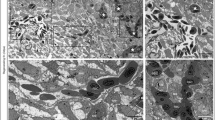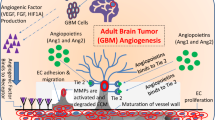Abstract
The Hedgehog family of proteins are powerful morphogens mediating embryonic development as well as adult morphogenesis and carcinogenesis. For example, excess hedgehog activity has been implicated in basal cell carcinoma, medulloblastoma and rhabdomyosarcoma. More recently, hedgehog signalling has been implicated in angiogenesis. While hedgehog signalling in adult angiogenesis may constitute a simple recapitulation of that in embryonic development, it should be appreciated that Hedgehog signalling occurs in embryonic angiogenesis in different developmental contexts. This article reviews the role of Hedgehog signalling in both embryonic and postnatal vascular development. The temporal importance of a window of hedgehog dependent angiogenesis during development is emphasised and illustrated using a whole mouse embryo culture system.



Similar content being viewed by others
References
Cohen MM Jr (2003) The hedgehog signalling network. Am J Med Genet A 123:5–28
Nagase T, Nagase M (2007) Time windows of hedgehog signalling in craniofacial and vascular development: Analyses using a mouse whole embryo culture system. In: Grachevsky N (ed) Signal transduction research trends. NOVA Science Publishers, Hauppauge, pp 131–170
Pola R, Ling LE et al (2001) The morphogen Sonic hedgehog is an indirect angiogenic agent upregulating two families of angiogenic growth factors. Nat Med 7:706–711
Byrd N, Grabel L (2004) Hedgehog signalling in murine vasculogenesis and angiogenesis. Trends Cardiovasc Med 14:308–313
Lavine KJ, Ornitz DM (2007) Rebuilding the coronary vasculature: hedgehog as a new candidate for pharmacologic revascularization. Trends Cardiovasc Med 17:77–83
Donahue JK (2006) Gene therapy, angiogenesis, Sonic Hedgehog: Sonic the Hedgehog to the rescue? Gene Ther 13:998–999
Nagase T, Nagase M et al (2007) Hedgehog signalling: a biophysical or biomechanical modulator in embryonic development? Ann N Y Acad Sci 1101:412–438
Mann RK, Beachy PA (2004) Novel lipid modifications of secreted protein signals. Annu Rev Biochem 73:891–923
Burke R Nellen D et al (1999) Dispatched, a novel sterol-sensing domain protein dedicated to the release of cholesterol-modified hedgehog from signalling cells. Cell 99:803–815
Kalderon D (2005) The mechanism of hedgehog signal transduction. Biochem Soc Trans 33:1509–1512
Aza-Blanc P, Ramirez-Weber FA et al (1997) Proteolysis that is inhibited by hedgehog targets Cubitus interruptus protein to the nucleus and converts it to a repressor. Cell 89:1043–1053
Lum L, Zhang C et al (2003) Hedgehog signal transduction via Smoothened association with a cytoplasmic complex scaffolded by the atypical kinesin, Costal-2. Mol Cell 12:1261–1274
Chen JK, Taipale J et al (2002) Inhibition of Hedgehog signalling by direct binding of cyclopamine to Smoothened. Genes Dev 16:2743–2748
Roelink H, Porter JA et al (1995) Floor plate and motor neuron induction by different concentrations of the amino-terminal cleavage product of sonic hedgehog autoproteolysis. Cell 81:445–455
Jessell TM (2000) Neuronal specification in the spinal cord: inductive signals and transcriptional codes. Nat Rev Genet 1:20–29
Panman L, Zeller R (2003) Patterning the limb before and after SHH signalling. J Anat 202:3–12
Chiang C, Litingtung Y et al (1996) Cyclopia and defective axial patterning in mice lacking Sonic hedgehog gene function. Nature 383:407–413
Athar M, tang X et al (2006) Hedgehog signalling in skin development and cancer. Exp Dematol 15:667–677
Dellovade T, Romer JT et al (2006) The hedgehog pathway and neurological disorders. Annu Rev Neuroci 29:539–563
Lawson ND, Vogel AM et al (2002) Sonic hedgehog and vascular endothelial growth factor act upstream of the Notch pathway during arterial endothelial differentiation. Dev Cell 3:127–136
Vokes SA, Yatskievych TA et al (2004) Hedgehog signalling is essential for endothelial tube formation during vasculogenesis. Development 131:4371–4380
Lavine KJ, White AC et al (2006) Fibroblast growth factor signals regulate a wave of Hedgehog activation that is essential for coronary vascular development. Genes Dev 20:1651–1666
Van Tuyl M, Groenman F et al (2007) Angiogenic factors stimulate tubular branching morphogenesis of sonic hedgehog-deficient lungs. Dev Biol 303:514–526
White AC, Lavine KJ et al (2007) FGF9 and SHH regulate mesenchymal Vegfa expression and development of the pulmonary capillary network. Development 134:3743–3752
Kanda S, Mochizuki Y et al (2003) Sonic hedgehog induces capillary morphogenesis by endothelial cells through phosphoinositide 3-kinase. J Biol Chem 278:8244–8249
Hochman E, Castiel A et al (2006) Molecular pathways regulating pro-migratory effects of Hedgehog signalling. J Biol Chem 281:33860–33870
Asai J, Takenaka H et al (2006) Topical sonic hedgehog gene therapy accelerates wound healing in diabetes by enhancing endothelial progenitor cell-mediated microvascular remodelling. Circulation 113:2413–2424
Lee SW, Moskowitz MA et al (2007) Sonic hedgehog inversely regulates the expression of angiopoietin-1 and angiopoietin-2 in fibroblasts. Int J Mol Med 19:445–451
Byrd N, Becker S et al (2002) Hedgehog is required for murine yolk sac angiogenesis. Development 129:361–372
Chung Ul, Schipani E et al (2001) Indian hedgehog couples chondrogenesis to osteogenesis in endochondral bone development. J Clin Invest 107:295–304
Colnot C, de la Fuente L et al (2005) Indian hedgehog synchronizes skeletal angiogenesis and perichondrial maturation with cartilage development. Development 132:1057–1067
Kusano KF, Allendoerfer KL et al (2004) Sonic hedgehog induces arteriogenesis in diabetic vasa nervorum and restores function in diabetic neuropathy. Arterioscler Thromb Vasc Biol 24:2102–2107
Pola R, Ling LE et al (2003) Postnatal recapitulation of embryonic hedgehog pathway in response to skeletal muscle ischemia. Circulation 108:479–485
Surace EM, Balaggan KS et al (2006) Inhibition of ocular neovascularisation by hedgehog blockade. Mol Ther 13:573–579
Kusano KF, Pola R et al (2005) Sonic hedgehog myocardial gene therapy: tissue repair through transient reconstitution of embryonic signalling. Nat Med 11:1197–1204
Velcheti V (2007) Hedgehog signalling is a potent regulator of angiogenesis in small cell lung cancer. Med Hypotheses 69:948–949
Olsen CL, Hsu PP et al (2004) Hedgehog-interacting protein is highly expressed in endothelial cells but down-regulated during angiogenesis and in several human tumors. BMC Cancer 4:43
Nagase T, Nagase M et al (2005) Angiogenesis within the developing mouse neural tube is dependent on sonic hedgehog signalling: possible roles of motor neurons. Genes Cells 10:595–604
Nagase T, Nagase M et al (2006) Defects in aortic fusion and craniofacial vasculature in the holoprosencephalic mouse embryo under inhibition of Sonic hedgehog signalling. J Craniofac Surg 17:736–744
Nagase M, Nagase T et al (2006) Critical time window of hedgehog-dependent angiogenesis in murine yolk sac. Microvasc Res 71:85–90
Osumi N, Inoue T (2001) Gene transfer into cultured mammalian embryos by electroporation. Methods 24:35–42
Nagase T, Nagase M et al (2005) Craniofacial anomalies of the cultured mouse embryo induced by inhibition of sonic hedgehog signalling: an animal model of holoprosencephaly. J Craniofax Surg 16:80–88
Dyer MA, Farrington SM et al (2001) Indian hedgehog activates hematopoiesis and vasculogenesis and can respecify prospective neurectodermal cell fate in the mouse embryo. Development 128:1717–1730
Nakao T, Ishizawa A et al (1988) Observations of vascularisation in the spinal cord of mouse embryos, with special reference to development of boundary membranes and perivascular spaces. Anat Rec 221:663–677
Sato TN, Tozawa Y et al (1995) Distinct roles of the receptor tyrosine kinases Tie-1 and Tie-2 in blood vessel formation. Nature 376:70–74
Author information
Authors and Affiliations
Corresponding author
Rights and permissions
About this article
Cite this article
Nagase, T., Nagase, M., Machida, M. et al. Hedgehog signalling in vascular development. Angiogenesis 11, 71–77 (2008). https://doi.org/10.1007/s10456-008-9105-5
Published:
Issue Date:
DOI: https://doi.org/10.1007/s10456-008-9105-5




